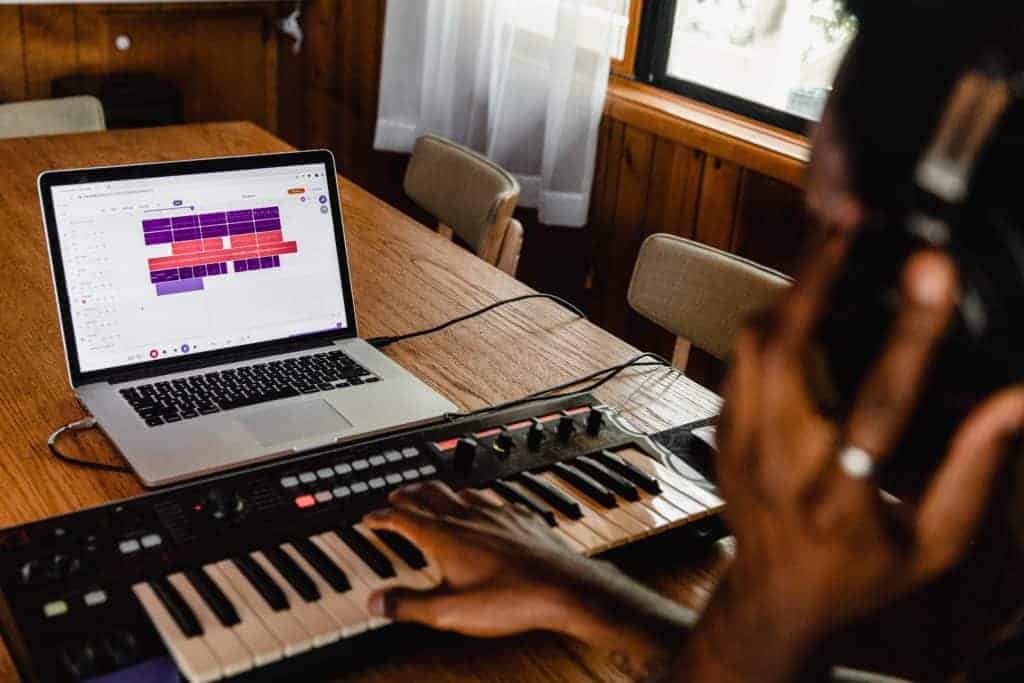Today, we’ll talk deeply about arrangement and how to enhance your track only by getting them arranged perfectly!
Your track is composed of five parts that are equally important for any track: Composition, Arrangement, Sound Design, Mixing and Mastering. In this post, we’ll be talking exclusively about one of them: Arrangement. The process of arranging the elements of a track throughout its structure is one of the key elements to keep the listener interested in your track in a competitive market.
In that sense, today we’ll talk about the importance of a cohesive arrangement for your tracks, how to maintain an arrangement that works, how referencing can help you make better arrangement decisions, and some arrangement hacks and tips.

Here’s what we’ll talk today:
- Studying Your Genre’s Section Arrangement
- Studying Each Section of the Track
- Current vs Last 8 Bar Loop Progression
- Is This Cheating?
Let’s dive right in!
Studying Your Genre’s Section Arrangement
All genres vary in how the tracks are built, and normally they follow a pattern that can be studied and applied to your track. Look at the three Prog Trance tracks:

And you can listen to it below:
Lux by Leo Lauretti & Paul Arcane:

And you can listen to it below:
Luna by Paul Arcane & Leo Lauretti:

And you can listen to it below:
Looking at these three songs, we can all notice some things:
- The INTRO is composed of four 8bl, in which the first two you have no bass and the last two you have an introduction to the bass coming on DROP 1;
- DROP 1 is either three or fours 8bl, depending on the track;
- BREAKs can range from four to six 8bl;
- All three DROP 2s have four 8bl;
- Two tracks have one 8bl BRIDGEs to DROP 3;
- All tracks have their DROP 3 with two 8bl;
- All OUTROs are two 8bl long.
Ok, this gives me a good outline to understand the arrangement of the sections in this genre, and this is considering if I didn’t know a thing about it. Not only this helps me understand the structure, but we can go a bit deeper and understand the elements of a section as well. In other words, this gives you a frame of reference to what is the standard of the market. You don’t have to follow it, but you could definitely use it as a guide when creating your track.
If you want to learn how I do it, for example, check the video below or go to this post to learn more:
Studying Each Section of the Track
To simplify this post, let’s look at the Drop 1 of my track along with Paul Arcane ‘Luna’, which starts at bar 33. How many melodic elements do you have there? Which elements are playing? What frequencies are they mainly playing? How many percussion elements do you have there? Ok, you’re creating now an outline to how you can start your drop 1. But how will we end it? The same process applies if we look at bar 49:

How many melodic elements do you have there? Which elements are playing? What frequencies are they mainly playing? How many percussion elements do you have there?
For example, let’s say you had 3 percussive elements at bar 33 and 7 percussive elements at bar 49. Ok, did you add these other 4 elements all in bar 49, or did I add 2 at bar 41 and 2 at bar 49?
When you listen to tracks with this perspective, you’ll dissect and understand how producers you like are creating their DROP 1s. You’ll learn how they created the movement in a track you really like, so why not apply this to your track?
By having this scientific approach to your sections, you’ll be able to dissect all elements that compose a section. This will give you a good outline to which elements to put next, when to put them, and how they keep the sense of progress in your track.
Current vs Last 8 Bar Loop Progression
In my opinion, every new 8 bar loop needs to have a change. If it doesn’t, what’s the point of even being there. It’s an aggressive approach, but it’s an approach that aims to keep the listener interested by always adding something new.
It could be a section change, it could be an addition of a percussive element like a shaker or hit hats, anything could work to keep your listener attentive to your track instead of saying “ahh, nothing new here, next”.
It’s important to mention that this counts for percussive and melodic elements. Adding a hit hat may not be enough, so opening the cutoff or adding a new melodic element could help to not only progress in one area of your track.
This helps develop the sense of progression that I talked about. It creates movement in the track and keeps the listener interested in what’s next in this track.
Lastly, movement can be generated not only by adding elements, but also by removing elements. Whenever there’s a big section change, it normally happens by taking off elements. Although I don’t like to take elements off when you’re building the track, especially when you’re finishing your track, movement can be generated by taking stuff off the arrangement.
Is This Cheating?
Let’s say you’re Enzo Ferrari, the founder of Ferrari, and Lamborghini released an innovative car that consumes 80% less gas than your current top model. You have an idea of how they did it, but you don’t really know how. What would you do?
I can guarantee you that if this happened to me I’d be the first customer (probably would change my name =D) to buy this car and then tear apart to understand what’s going on. Understanding what’s happening, I’d apply the technique to my design.

Is this cheating? In a business perspective, that’s surviving. In a music perspective, this does make your creation more mechanical and more “templated”, however if 80% of the tracks in this genre follow this template, why not? Take into account that EVERY genre is templated, from Gospel to Pop, they all follow the same structure, but they can be unique in their own way, either in the composition on and/or in the sound design. So, to me, this is not cheating, this is learning!
———————
Now I want to hear from you:
Arrangement could be a tricky business, and getting it right is the first aspect of a succsefull track. As with music, there is no magic formula, but learning from other could be a great way to get used to how to arraged tracks.
Now I’d like to hear what you have to say:
How do you come up with arrangement of your track?
Let me know in the comments below!